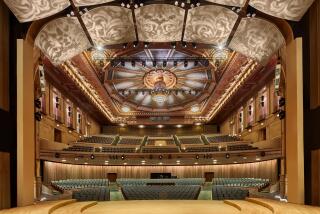Beloved Ballroom in Long Beach May Soon See Its Last Waltz : Entertainment: An attempt to revive old-fashioned dancing might be cut short by a developer’s plans.
- Share via
The band was called The Good Sounds, and its selections included rumbas, cha-chas, fox trots and waltzes.
For many of the dancers gathered on a recent Friday night at the International Ballroom in downtown Long Beach, The Good Sounds’ music provided a reminder of a bygone era in which couples glided gracefully around the dance floor.
“We grew up before television, when dancing was our main entertainment,” said Gene Shawgo, 73. “It’s very difficult to find places to do this kind of dancing now.”
His partner, Jean Sokolowski, added: “This is the best kind of dancing because you dance right with the music and cheek to cheek. This place used to be so packed that you couldn’t find a spot on the floor.”
That was in the 1950s, ‘60s and ‘70s, before the facility changed its name to Fender’s International Ballroom and began attracting so many punk rockers that the city eventually shut it down as a public nuisance.
Now, owner Edward McMahon has reopened the ballroom and is trying to revive the old-fashioned dancing. “What goes around comes around,” said McMahon, who organized large ballroom dances at the facility, 521 E. 1st St., through most of the 1970s.
Since reopening the building two months ago, he has offered ballroom-dance classes Friday and Sunday evenings, followed by several hours of open dancing. On Saturday nights, he said, the ballroom is available for rental.
The revival may be short-lived, however. The ballroom crowds so far have fallen far below the 200 dancers McMahon says he needs each night to break even. And a local developer who is interested in building condominiums on the site has an option to purchase the property, McMahon said.
Ruthann Lehrer, the city’s historical preservation officer, said she would have no objection to a condominium project. “It has no architectural significance worthy of preservation,” Lehrer said of the structure. “Whatever character the building had by being a vintage building has been obscured by alterations and remodeling.”
The 15,000-square-foot structure, built in the 1920s, was first used as a garage for the adjacent Lafayette Hotel. It was converted into a ballroom in 1956 by an ambitious hotel manager, Dave Tallichet, who noticed a dearth of banquet and ballroom facilities in the area.
“There really weren’t any good hotels in those days,” said Tallichet, 68, now president of Specialty Restaurants Corp., a company owning 75 restaurants nationwide, including The Reef in Long Beach. “For a few years (the International Ballroom) was the social headquarters of Long Beach.”
Among other things, he said, the ballroom hosted parties associated with some of the earliest Miss Universe Pageants, which were then held in the city. The ballroom was also rented out for big banquets, dances, social and political gatherings and, in later years, even a few prizefights. By the early 1970s its Friday night ballroom dances were attracting as many as 700 people, although interest in ballroom dancing had started to decline elsewhere.
Eventually, however, the waltzers gave way to punkers. A promoter named John Fender assumed control of the place in 1984 and brought in punk and heavy-metal bands. One show at Fender’s resulted in a confrontation between a group of white-supremacist skinheads, who were attracted by a particular band, and anti-skinhead protesters. And in 1988, rock fans clashed with police at one overcrowded concert.
Two years ago, when neighbors complained of excessive noise, littering and drug use, the City Council voted to revoke the ballroom’s business license. Eventually, when the legal dust settled, it was turned back over to McMahon, who had purchased the facility in 1986 for investment purposes but leased it to Fender.
McMahon recently sold the option on the property to Phil Appleby, chief executive officer of Shaw Properties, who plans to demolish the old building to make way for 40 condominium units.
A spokesman for Appleby said the development plans are in “the really early stages” and would take some time to complete.
While he’s waiting, McMahon, 61, has decided to give ballroom dancers a few more twirls.
So far the dances have been mere shadows of what they once were. On opening night, he said, the ballroom drew a crowd of about 160. Since then, he said, the number has dwindled to between 30 and 80 per dance.
Many of the ballroom’s customers said they used to attend dances there, but stopped coming during the Fender years. In the old days, McMahon said, the ballroom attracted such big-name groups as the Orin Tucker Band, the Russ Morgan Band and the Jan Garber Orchestra. Now The Good Sounds, a combo, plays such favorites as “Moon River,” “Chattanooga Choo-Choo” and “New York, New York.”
The dancers--mostly couples in their 60s and 70s--glide across the huge parquet floor in graceful, synchronized moves that most say took them years to perfect. Between numbers, they sit around candle-lit tables sipping soft drinks and reminiscing.
“I have a few memories of this place where I met someone and it developed into something,” said Harold Eilers, 67. “You got a higher class of women here.”
Berta Johnson, 66, said: “You could be depressed. You’d come here and dance and you’d feel happy.”
As for the present, though, almost everybody had the same concern.
“When I used to come here it was packed,” said Louise Mathison, 52. “I don’t know where they all went.”


